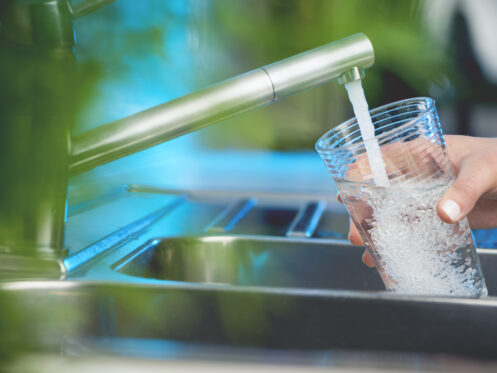Having adequate water pressure is crucial for the smooth functioning of your plumbing system, but at times, you may encounter the frustrating issue of low water pressure. Various factors can contribute to this problem, stemming from different aspects of the plumbing infrastructure. Understanding the diverse range of reasons behind low water pressure is essential in identifying the specific cause and implementing the appropriate solutions.
1. Clogged or Blocked Pipes
Blocked pipes are a reason for low water pressure in residential and commercial buildings. Over time, pipes can accumulate mineral buildup and sediment, leading to restricted water flow and decreased pressure. This issue can affect both hot and cold water lines, causing inconvenience and frustration for occupants.
Mineral buildup occurs when minerals like calcium and magnesium, commonly found in hard water, precipitate and adhere to the inner walls of pipes. This accumulation forms a layer of scale, reducing the diameter of the pipe and impeding the smooth flow of water. As the scale thickens, the water pressure decreases, resulting in weak water flow from faucets, showers, and other outlets.
Sediment accumulation is another factor that can contribute to low water pressure. Sediments such as sand, dirt, rust particles, and debris can enter the plumbing system through the main water supply or deteriorating pipes. Over time, these particles settle in the pipes, narrowing the passage for water to flow freely. As a result, the water pressure drops, causing inadequate water supply throughout the building.
Both mineral buildup and sediment accumulation are gradual processes that worsen over time. Older pipes are more prone to corrosion and sediment accumulation, exacerbating the problem. Additionally, areas with hard water, which contain higher mineral content, are more susceptible to mineral buildup.
2. Faulty Pressure Regulator
The pressure regulator is a device installed in the plumbing system to control and maintain the desired water pressure level. However, when this regulator malfunctions or if the pressure setting is incorrect, it can lead to a decrease in water pressure throughout the property.
A malfunctioning regulator valve is a specific issue that can occur within the pressure regulator. Over time, these valves may wear out, become damaged, or get stuck in a partially open or closed position. This can restrict the flow of water and result in low water pressure. The malfunctioning valve may also cause inconsistent pressure, where the water pressure fluctuates intermittently.
Another factor contributing to low water pressure is an incorrect pressure setting on the regulator. The pressure regulator is typically adjustable, allowing users to set the desired water pressure level for their specific needs. If the pressure setting is too low, it will result in inadequate water pressure throughout the property.
3. Leaks in the Plumbing System
Pipe leaks are a major culprit behind low water pressure. Over time, pipes can develop cracks, holes, or loose connections due to corrosion, aging, or excessive pressure. Pipe leaks can occur in both visible and hidden sections of the plumbing system, making them difficult to detect. Common signs of pipe leaks include damp spots on walls or ceilings, mold or mildew growth, or a noticeable decrease in water pressure.
Faucet or fixture leaks can also contribute to low water pressure. When faucets or fixtures such as shower heads, toilets, or sinks develop leaks, they create an additional pathway for water to escape, resulting in reduced pressure. Faucet leaks are often caused by worn-out washers or faulty seals, while a fixture may have damaged internal components or loose connections making them leak.
4. Water Supply Issues
Another reason for low water pressure in households is water supply issues, particularly problems with the municipal water supply or low water pressure from the main source. This can affect numerous homes or even entire neighborhoods.
A possible problem is an aging or deteriorating water distribution system. Over time, pipes may become corroded, develop leaks, or suffer from blockages due to sediment or mineral buildup. These issues can restrict the flow of water, causing a decrease in water pressure. Additionally, infrastructure damage caused by natural disasters, construction work, or accidents can also disrupt the water supply and lead to low pressure. In some cases, the main water source itself may have low pressure, impacting the water pressure in surrounding areas.
Insufficient infrastructure, such as undersized pipes or limited pumping capacity, can restrict the volume of water flowing into the distribution system. If the demand for water exceeds the capacity of the source, it can result in decreased pressure for consumers connected to that specific water supply.
5. Plumbing System Design
Plumbing system design plays a significant role in determining water pressure throughout a building. Low water pressure might be because of inadequate pipe sizing and poor layout or configuration.
Inadequate pipe sizing refers to the situation where the pipes in the plumbing system are not appropriately sized to accommodate the required water flow. When pipes are too small in diameter, they create resistance to the flow of water, leading to reduced pressure at the fixtures.
Poor layout or configuration of the plumbing system can also contribute to low water pressure. This occurs when the pipes are not arranged in an efficient manner or when there are excessive bends, twists, or turns in the piping network. Such obstacles can impede the smooth flow of water, causing pressure drops along the pipeline.
6. Water Pressure Reduction Devices
Water pressure reduction devices are often implemented to conserve water or regulate high water pressure, but they can inadvertently lead to decreased water pressure if not properly installed or maintained. While they contribute to water conservation efforts, they can also result in reduced water pressure. The restricted water flow can create a sensation of weak water pressure, making tasks like showering or washing dishes less efficient and potentially frustrating.
Pressure-reducing valves (PRVs) regulate excessively high water pressure coming into a building. They serve an essential function in protecting plumbing fixtures and preventing water damage. However, if a PRV is not functioning correctly or has been incorrectly adjusted, it can cause water pressure to drop below-desired levels. Improperly set PRVs may restrict water flow excessively, resulting in reduced water pressure throughout the plumbing system.
7. Water Meter or PRV Malfunction
A malfunctioning water meter or pressure-reducing valve (PRV) is a significant factor that can lead to low water pressure in a plumbing system. A defective water meter, which measures the amount of water flowing into a property, can restrict the water flow and cause low pressure. Over time, water meters may wear out, become damaged, or accumulate sediment, hindering accurate measurement and impeding water flow.
Similarly, a faulty PRV can contribute to low water pressure. The PRV is responsible for regulating and maintaining a consistent water pressure level in a building. This can result in insufficient water pressure throughout the plumbing system, affecting various fixtures and appliances that rely on adequate pressure for proper functioning.
Contact Us Today!
At Cozy Home Services in Vacaville, California, we provide plumbing repairs, water filtration services, and water heater services for your home. Our friendly team also provides cooling, heating, and indoor air quality services. Contact Cozy Home Services for more information today!



